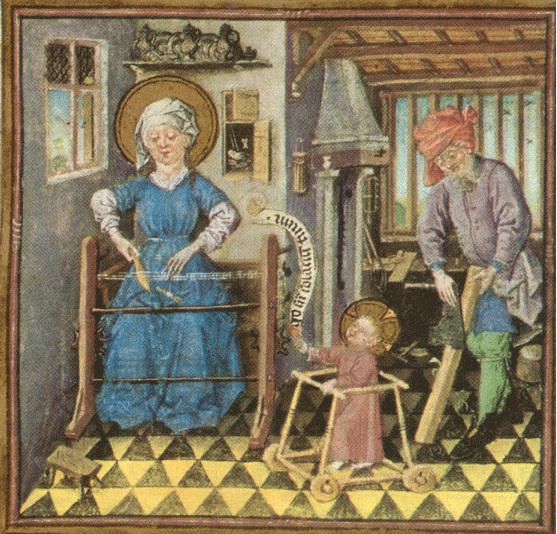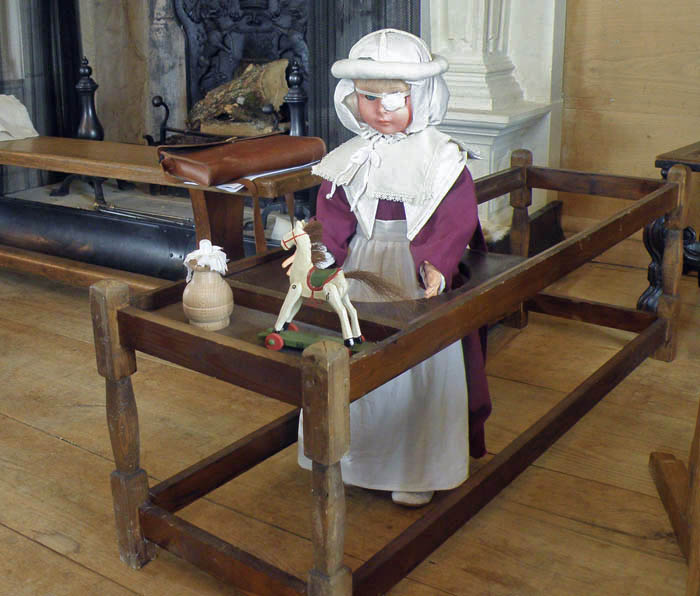
The baby walker is a device to support an infant who is not yet independently mobile to ‘walk’ around. In the past they were thought to aid the child’s development as she learned to walk.
Images of the baby walker date back at least to the fifteenth century, such as in the image below, which is thought to date to the 1440s and which depicts Christ in a walker while his mother is free to continue her work:

There are a whole array of similar images of Christ in a babywalker. Some can be viewed on this blog.
Other historical images include this fifteenth-century German woodcut in the Wellcome collection. The fact that this image is catalogued as a playpen highlights the duel function of the baby walker.
Controversy
The use of the baby walker has long been controversial. In the 1980s, one study found that
Of 195 patients (age range, 5 to 15 months) surveyed during a three-month period, 150 patients (77%) used infant walkers. Of those, 47 patients (31%) had suffered mishaps. These included closed head trauma, fractures, lacerations, tooth evulsion, and soft palate perforation. There is no proved benefit associated with the use of such walkers.[1]
The number of injuries associated with these aids meant that in April 2004, Canada banned the sale of them. Indeed there ‘possession of a baby walker can lead to fines up to $100,000 or six months in jail ’.[2] Physician Dr Alan Greene acknowledges that babies do seem happy when they are propelling themselves across the floor and that there are times when, just like Mary in the image above, ‘parents need to get things done. Sometimes parents use walkers as a baby-sitter, to keep their baby occupied and entertained so they do other things’.[3] However he cautions that
Back in 1994, when baby walkers were still extremely popular in the United States, the Consumer Products Safety Commission declared that baby walkers were responsible for more injuries than any other children’s product. The types of injuries included head injuries, broken bones, broken teeth, burns, entrapment of fingers and even amputations or death.[4]
The reason for so many of these accidents, according to De Greene, is simply that:
Walkers allow mobility beyond a baby’s natural capability, and faster than a parent’s reaction time. Most of the injuries involve falls down stairs, but injuries can also come, for instance, from allowing reach to hot, heavy or poisonous objects. Today’s walkers are safer, but they are still hazardous – and of no benefit to the baby.
Early Modern Solution?
The baby walker on view at Harvington Hall in Worcestershire is thought to be sixteenth century.[1] It is essentially a fixed frame walker in which the child can propel itself forwards or backwards, but does not have the freedom of movement an unrestricted walker provides. This means the child cannot fall in the fire, down the stairs, or access anything their parents have placed out of reach.


The Harvington walker isn’t a unique piece of equipment and other examples like the one on the left can be seen.
Perhaps our ancestors were alert to the problems and potential dangers of the free wheeling baby walker and had found a way to offset the problems, and we could learn from these examples!
[1] <http://www.harvingtonhall.com/ > photographs April 2015, taken by permission of the tour guide.
[1] Carol A. Kavanagh, MD; Leonard Banco, MD ‘The Infant Walker: A Previously Unrecognized Health Hazard’ Am J Dis Child. 1982;136(3):205-206. doi:10.1001/archpedi.1982.03970390019005. <http://archpedi.jamanetwork.com/article.aspx?articleid=510349> [last accessed May 2015].
[2]As reported in the New York Times 22 February 2010. See ‘The Dangers of Baby Walkers’ <http://consults.blogs.nytimes.com/2010/02/22/the-dangers-of-baby-walkers/?_r=0> [last accessed May 2015].
[3] As above.
[4] As above.


